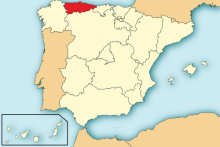

The Principality of Asturias is characterised as a coastal-mountain region on middle latitudes, a circumstance that significantly affects its climate. Accordingly, climate change has significant effects on the physical and biological systems associated with said unique circumstance.
There is much evidence to show that the climate is changing in this region, affecting its biodiversity, forests and farming, coasts, oceans and water resources. The changes that have been observed have been included in the document titled Evidence and Potential Effects of climate change in Asturias, drawn up by a panel of experts from different areas of research and knowledge.
Accordingly and by way of example, special mention can be made of an average increase in atmospheric temperature of 0.21°C per decade since the 1960s; over the last 20 years, the average temperature of seawater has constantly increased by more than 0.3°C per decade. Furthermore, sea levels have increased at a rate of approximately 3 mm per year.
The impact of these climate changes has a special effect on the more vulnerable terrestrial and marine ecosystems that are characteristic of our region, such as the animal and plant life typical of our mountain areas and the extensive planktonic and coastal biodiversity associated with Asturias.
The forecasts based on climate models drawn up according to the time variations of different variables, included in the Analysis of Climate Change Scenarios in Asturias, predict the displacement of certain species to higher altitudes and more northern latitudes, early blossoming in spring and more pests and biological invasions, the reduction of fishing resources and coastal species, an increase in flood levels and the backward movement of the coastline. It is also expected that climate change will threaten species in danger of extinction.
Knowledge of the main effects of climate change in the Principality of Asturias have led to research and knowledge aimed at strengthening lines of action in this area, basically focusing actions on reducing the vulnerability of natural systems. This has led to the recuperation of endangered animal and plant species and the elimination of invasive pests and plants, fire-prevention strategies and the conservation of coastal areas. These lines must remain part of the future development of plans, programmes and strategies for adaptation to climate change, with special reference to the coast and poor areas, incorporating the climate variable in territorial planning and sector policies.
1.A. Marco general jurídico y políticas de adaptación | |||
|---|---|---|---|
Ley, Estrategia, Plan, Programa | Fecha de aprobación | Régimen jurídico | Enlaces/doc. relacionada |
Estrategia Asturiana de Acción por el Clima | En elaboración | - | |
Plan de Adaptación al Cambio Climático del DPMT adscrito al Principado de Asturias | En elaboración | Disposición Adicional Octava de la Ley 2/2013, de 29 de mayo, de protección y uso sostenible del litoral y de modificación de la Ley 22/1988, de 28 de julio, de Costas | Actuaciones del Gobierno de Asturias en materia de cambio climático |
1.B. Estructura de coordinación y gestión institucional para la adaptación al cambio climático. Gobernanza horizontal y vertical | ||||
|---|---|---|---|---|
|
| Observaciones | Enlaces/doc. relacionada | Actores representados[1] |
Organismo responsable | Consejería de Administración Autonómica, Medio Ambiente y Cambio Climático | Responsable de la coordinación de la acción del Gobierno en relación con el cambio climático, impulsando las medidas y acciones que en esta materia hayan de adoptarse por las distintas Consejerías en sus respectivos ámbitos sectoriales. | Administración Autonómica | |
Órgano de coordinación | Comisión de Coordinación de Acción por el Clima de Asturias | Órgano colegiado interdepartamental de asesoramiento y coordinación de las acciones administrativas y de gobierno en materia de cambio climático y que conciernen a diversos ámbitos competenciales de la Administración del Principado de Asturias. | Decreto | Administración Autonómica |
Órgano de participación | Observatorio de la Sostenibilidad en el Principado de Asturias | Órgano colegiado de carácter consultivo, adscrito a la Consejería competente en materia de Medio Ambiente, que informa de las políticas, estrategias, acuerdos y programas medioambientales y para la sostenibilidad medioambiental promovidas desde el ámbito regional y efectúa un seguimiento de las mismas, incluyendo las relacionadas con el cambio climático. | Administración Autonómica, Administración General del Estado, Entidades locales, empresariado, Universidad de Oviedo, asociaciones de consumidores y usuarios, asociaciones vecinales y entidades conservacionistas | |
[1] Administración central, autonómica, local, ONG, academia, empresas, etc.
Consejería de Fomento, Ordenación del Territorio y Medio Ambiente
Dirección General de Sostenibilidad y Cambio Climático
C/ Coronel Aranda, 2
33005 OVIEDO
www.asturias.es




